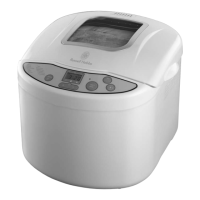using the recipes
1 Tablespoons (tbsp) are 15ml, teaspoons (tsp) are 5ml.
2 Spoons should be level, not heaped.
3 Measure everything with the same set of measuring spoons.
4 Weighing water (1g=1ml) is more accurate than using a measuring jug.
5 Dried milk should be dried skimmed milk.
6 Use new, unopened, sachets of dried yeast – check the “best before” dates.
7 If you don’t use all the yeast in a sachet, throw it away, don’t save it – it’ll go stale.
8 Use flour marketed as “strong flour” or “bread-making flour” – ordinary flour won’t work.
9 Don’t open the lid unless you absolutely have to – then close it again.
10 The best bread knife has a toothed blade a bit like a hacksaw blade – use it to saw the bread,
without much pressure, so the bread doesn’t become distorted.
, Put the ingredients into the loaf tin in the correct order – we’ve numbered them, to make it
easier to follow the recipes.
troubleshooting – what to do if:
the bread collapsed
1 The dough may have been too moist. Reduce the recipe liquid by 2 tbsp. If tinned fruit was
used, it may not have been properly drained.
2 Leaving the bread in the loaf tin while it cools can cause moisture released in the baking
process to soak back into the bread.
3 The flour may have been too coarsely ground. Try using finer flour.
the bread didn’t rise
1 One or more ingredients were added in the wrong quantities – accuracy is essential
2 The yeast is stale – check the “best before” date – use a fresh, unopened sachet every time
the core of the bread is too moist
1 The dough may have been too moist, see above.
2 The flour may have been too heavy. This problem can occur with rye, bran and wholemeal
flours. Reduce the amount of heavy flour and replace with white flour.
the bread has swollen too much
1 You may have used too much yeast, try reducing it slightly.
2 Too much sugar can cause the yeast to work too fast, and the bread to rise too much. Try
reducing the amount of sugar. If you add sweet/sugary ingredients such as dried fruit, honey
or molasses, reduce the amount of sugar to compensate.
3 You might try reducing the recipe liquid by 2 tbsp, as this will slow the action of the yeast.
4 Use a coarser flour. Less yeast is needed with fine flour than with the same type of flour
ground coarsely.
the bread tastes bland
Try increasing the amount of salt by up to ¼ of a teaspoon.

